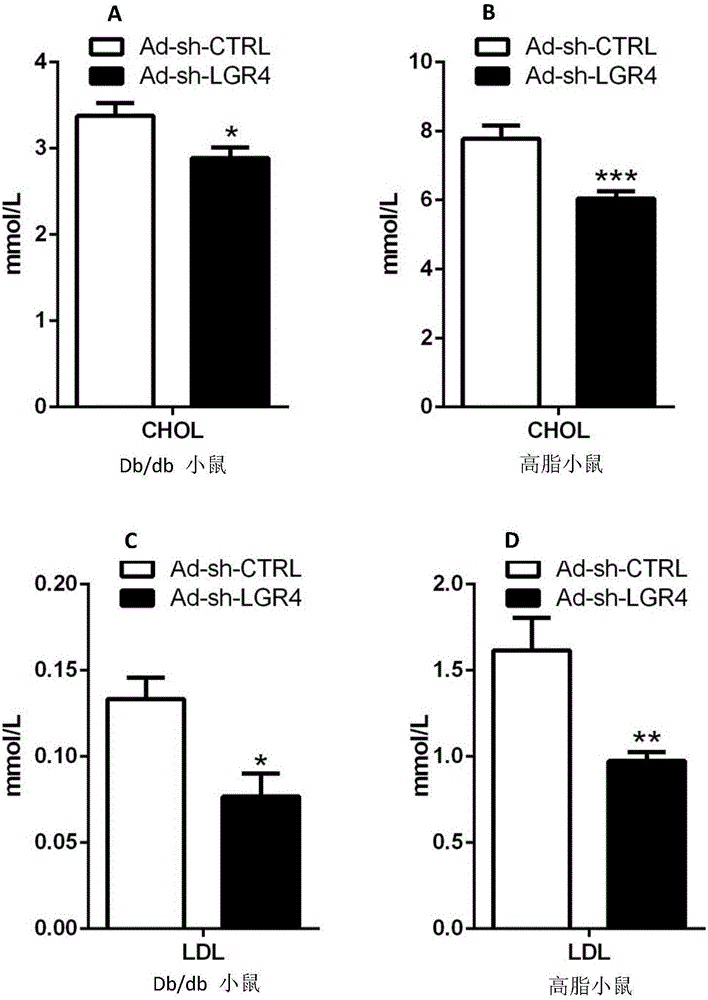LGR4 gene/protein for screening medicine for treating hypercholesteremia
A technology for hypercholesterolemia and cholesterol, applied in the fields of biotechnology and medicine, can solve the problems that the specific role of LGR4 has not been deeply explored, and no research has revealed the impact of LGR4, so as to achieve good application prospects, reduce blood cholesterol levels, and reduce low density Effect of lipoprotein cholesterol levels
- Summary
- Abstract
- Description
- Claims
- Application Information
AI Technical Summary
Problems solved by technology
Method used
Image
Examples
Embodiment 1
[0024] Example 1. Establishment of adenovirus-mediated liver-specific LGR4 gene knockout mice
[0025] 20 db / db mice were raised in the animal room of the Institute of Endocrinology, School of Medicine, Shanghai Jiaotong University. Body weight calibration, respectively for the control group (Ad-sh-CTRL) and the LGR4 knockout group (Ad-sh-LGR4) two groups. After grouping, the rats were given tail vein injection of adenovirus, the control group was given 2*109pfu shNT adenovirus injection, and the LGR4 knockout group was given 2*109pfu shLGR4 adenovirus injection.
[0026] 24 high-fat mice were raised in the animal room of the Institute of Endocrinology, Shanghai Jiao Tong University School of Medicine. The ambient temperature was 22°C, with 12 hours / 12 hours of light and dark. db / db mice.
Embodiment 2
[0027] Embodiment 2, establish Lgr4; Leptin (Lgr4 m / m ; ob / ob) double-gene mutant mice
[0028] Lgr4 heterozygous mice were backcrossed with C57BL / 6 mice for at least 6 generations to obtain Lgr4 heterozygous mice with C57BL / 6 background. The mice obtained by mating these Lgr4 heterozygous mice with ob mice were designated as F2, and the Lgr4 and Leptin double mutant mice among the offspring obtained by crossing the F2 generation mice were used for the experiment, and the ob mice were used for the control. Three-month-old male and female mice were mated in cages at a ratio of 1:1 and 1:2. Three-week-old mice were weaned, marked, separated into cages, and genotyped.
Embodiment 3
[0030] Feeding conditions: mice were raised under clean-grade conditions, and the feeding density was 5 per cage, and were fed separately in standard mouse cages according to the following conditions: standard commercial mouse feed (4.5% fat, 4.0% cellulose, 21.0% Protein, 1.404 kcal / gram), high-fat feeding feed was purchased from Research Diet (60.0% fat), and the feed was replaced every other day according to the food intake of each mouse to ensure the freshness of the feed. The room temperature was 20-22 degrees Celsius, free access to food and water, and a stable artificial light cycle (6:00 to 18:00 light, 18:00 to 6:00 dark).
[0031] Two kinds of adenovirus injection mouse models were collected 10 days after injection of adenovirus, Lgr4; Leptin(Lgr4 m / m ; ob / ob) The double-gene mutant mouse model was collected at the age of 4 months. The feed of the animals in each group was removed at 17:00 the day before the collection, and the animals were fasted for 16 hours, and a...
PUM
 Login to View More
Login to View More Abstract
Description
Claims
Application Information
 Login to View More
Login to View More - R&D
- Intellectual Property
- Life Sciences
- Materials
- Tech Scout
- Unparalleled Data Quality
- Higher Quality Content
- 60% Fewer Hallucinations
Browse by: Latest US Patents, China's latest patents, Technical Efficacy Thesaurus, Application Domain, Technology Topic, Popular Technical Reports.
© 2025 PatSnap. All rights reserved.Legal|Privacy policy|Modern Slavery Act Transparency Statement|Sitemap|About US| Contact US: help@patsnap.com


